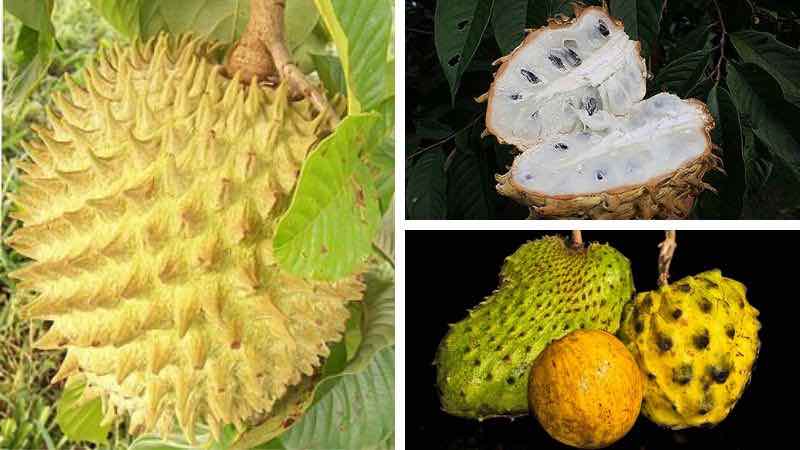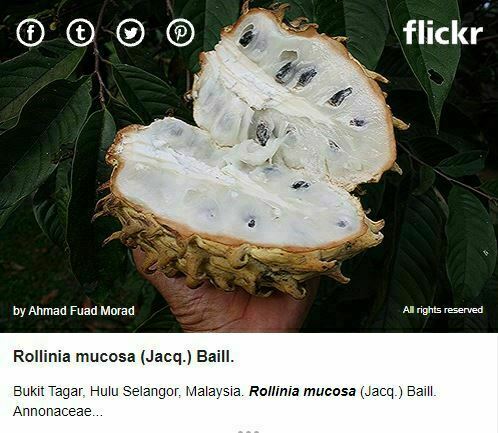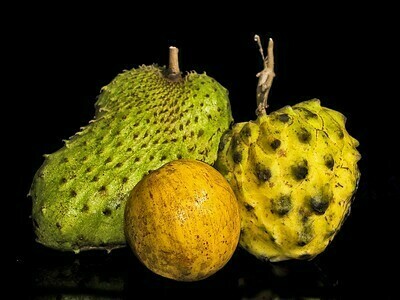
The Amazonian anon belongs to the Annoneaceae family, genus Rollinia, species Rollinia mucosa (Jacq) Baillon . It is commonly known as biribá, biribá de Pernambuco, fruta-do-conde, fruta da condessa, jaca de pobre, among others (Pimentel, 2020; Quevedo and Montañez, 1994).
There are approximately 65 species in the genus Rollinia, but only Rollinia mucosa is cultivated for its fruit (Janick and Paull, 2008). Synonyms: Annona mucosa Jacq. and Rollinia orthopetala A.DC. (Food and Agriculture Organization of the United Nations, FAO, 1987).
✅ Geographical distribution of the Amazonian Anon or Biribá
The probable origin of Rollinia mucosa is located at the western end of the Amazon Basin and it is now widely distributed throughout the lower humid tropics of the Amazon Basin, as well as occasionally in the southern Orinoco Basin.
This tree can be found in almost every orchard in the Amazon region, being a very popular fruit in the Brazilian and Colombian Amazon.
The Amazonian Anon is found mainly in Brazil, Colombia, Peru, Dominican Republic, Guadeloupe, Martinique and Trinidad (FAO, 1987).
✅ Anona amazonica tree characteristics
The Amazon Anon tree reaches a height between 6 and 10 meters and its leaves are about 15 cm long. Propagation is by seed and grafting; it enters into production between 3-5 years.
It is not grown commercially but can be found in orchards and market stalls as well as in local street sales. It requires fertile and well-drained soils, although it grows quite well in poor clay soils.
It requires average annual rainfall with a maximum average of 3,419 mm; maximum average annual temperature of 26°C and a variable altitude from sea level to 1,000 meters above sea level.
This tree flowers mainly between August and September and fruits from January to June (FAO, 1987; Ministry of Agriculture and Irrigation, Government of Peru, 2020).
✅ Anón Amazónico fruit characteristics
The fruit is globular, spherical, oblong, or conical, and has various sizes and weights, from 200 to 5,000 grams, being the color of the skin green and turns yellow with the ripening process (Quevedo and Montañez, 1994); it also has dotted protuberances like the pineapple.

The pulp of the Anón Amazónico is bank or cream colored, with a soft, fibrous and mucilaginous texture, juicy and with a less acid taste than the soursop; the seeds are dark brown to almost black (FAO, 1987).
The fruits are harvested by hand and special care must be taken not to mistreat the protuberances and even less to break them so as not to anticipate their oxidation.
✅ Nutritional value of Biribá
According to Montenegro and Guzmán, cited by Quevedo and Montañez (1994), the Anón Amazónico has a high sugar content similar to that of the guanábana (Annona muricata L.), and lesser in relation to the common anon (Annona squamosa L.) and cherimoya (Annona cherimola Mill); it is a good source of energy, vitamin C and minerals.
The nutritional composition of the Amazonian Anon per 100 grams of pulp is:
- Energy (53.0 cal.)
- Moisture (85.0 g.)
- Protein (1.1 g.)
- Lysine (316.0 mg/gN)
- Methionine (178.0 mg/gN)
- Threonine (219.0 mg/gN)
- Tryptophan (57.0 mg/gN)
- Lipids (ether extract) (0.4 g.)
- Carbohydrates (12.9 g.)
- Fiber (0.6 g.)
- Ash (0.6 g.)
- Vitamin A (Retinol) (0.0 g.)
- Thiamine (0.07 mg.)
- Riboflavin (0.23 mg.)
- Niacin (0.80 mg.)
- Vitamin C (Ascorbic A.) (43.40 mg.)
Source: (Ministry of Agriculture and Irrigation, Government of Peru, 2020).

In the image above, other anonas, from left to right: guanabana, custard apple and anona.
✅ Uses and benefits of the Amazonian Monkey for health
The ripe fruits of the Amazonian Anon are a source of food for birds and wild animals, as well as for human consumption.
It is eaten fresh or processed in the preparation of juices, sorbets, sweets and compotes; it is also added as a filling in cakes or pies.
According to the Ministry of Agriculture and Irrigation, Government of Peru (2020), second quality fruits are used for pig and fish feed.
On the other hand, the wood of the biribá tree is used as firewood and in the construction of boats and crates; it is also used in rural constructions and as a handle for tools (Ministerio de Agricultura y Riego, Gobierno de Perú, 2020).
At the same time, biribá helps to lose weight, since the fiber contained in the fruit provides a feeling of satiety.
In addition, because it is sweet, it can replace the consumption of industrialized sugar in other foods, that is, consume something sweet in a natural way; it also combats fatigue due to its potassium content (Pimentel, 2020).
It stimulates collagen production and inhibits free radicals, thus preventing premature aging and wrinkles (Pimentel, 2020).
✅ Prevention of known diseases
On the other hand, the consumption of the fruit and leaves of Biribá or Anón Amazónico, as well as its ground seeds, have favorable effects in the prevention and treatment of some diseases: anti-cancer properties are attributed to it.
In turn, it reduces the possibility of osteoporosis and strengthens bones; the leaf extract acts as an anti-inflammatory; it is also used to treat diseases such as diabetes, hypertension, depression, asthma and rheumatism (Pimentel, 2020).
Additionally, Biribá seed powder is used in natural medicine to treat colon and intestinal conditions, which usually present diarrhea, dysentery, colic, fever, vomiting and general malaise (Branco, 2017).
Finally, Vélez, quoted by Quevedo and Montañez (1994), states that this fruit is used in Brazil for medicinal purposes, as an analeptic (it has cardiovascular and respiratory effects on the body) and antiscorbutic due to its high vitamin C content.
Bibliography
- Branco, A. Biribá – uma Fruta-do-Conde diferente, grande e muito útil (17 de maio de 2017), retrieved from http://www.greenme.com.br.
- Janick, J. and Paull, R. 2008. The Encyclopedia of fruit & nuts. Cambridge: CAB International.
- Ministry of Agriculture and Irrigation, Government of Peru. 2020. Anona, retrieved from http://www.agroaldia.minagri.gob.pe.
- Food and Agriculture Organization of the United Nations, FAO. 1987. Forest species that produce fruits and other foods. Examples from Latin America. Rome: FAO.
- Pimentel, M. 2020. Benefícios do Biribá, retrieved from http://www.fruta.com.br.Quevedo, E. and Montañez, O. 1994. Preliminary anatomical study of root and shoot of Amazonian anon(Rollinia mucosa (Jacq) Baillon). Colombian Agronomy, vol. XI, (2), pp. 206-218.

Economist (Central University of Venezuela). Full professor and researcher attached to the “Edgar Abreu Olivo” Agrifood Research Center, Universidad de Los Andes. Doctor from the University of La Laguna (Spain). Award “One of the 10 most consulted authors of the Saber ULA university portal” (2005); prize in the III Essay Contest of the Central Bank of Venezuela BCvoz Economico, 2016, with the work “Theobroma cacao: transformation and consumption of the “food of the gods” in Venezuela and the world” (co-authored).
This post is also available in:
![]() Español (Spanish)
Español (Spanish)
